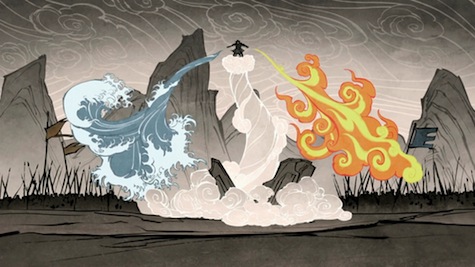If you had asked me if I thought The Legend of Korra or Avatar: the Last Airbender needed an origin story for the Avatar, I would have said no…but now that we’ve gotten one, I’m really into it. Telling the story of “the first Avatar” is intrinsically risky, as it threatens to undermine the structure of the whole story, but Wan’s tale is the story of a trickster turned hero. Wan is the Monkey King, complete with flying cloud; he is Prometheus the stealer of fire, he is Pandora, whose impulsive act threatens the world. I’m a big fan of the subversive mythology we see; the Avatar isn’t the ur-king—that’d be the oppressive Chous—he is instead the rebel. Besides, I’m just in general a backer of the Monomyth. You descend into the spirit world, Wan! The fact that he skips the most boring step, the refusal of the call, is an added bonus.
This has got to be one of the most Miyazaki-like episodes, hasn’t it? From the big strokes of mankind versus spirits, to the tiny little details, like Wan putting Raava in a tea kettle. Also in terms of dang this was pretty; the lush and saturated artwork of the episode was really stunning. Or as my notes say here “art = sweeeeeet.” (When Vaatu turns spirits dark, they look sort of like…the Oogie Boogie blacklight scene from Nightmare Before Christmas.) A while back I read Legend of the Five Rings: Imperial Histories, a role-playing game book that posits a number of alternate quasi-Japanese settings, including an almost pre-Edenic time where spirits and humans and demigods lived together. This reminded me of that, as well; it had the ambiance of an Aesop fable while having the narrative complexity you’d expect from a first person story. It isn’t just the rough hewn strokes of legend; it really does feel like Korra’s memories, the Avatar’s past.
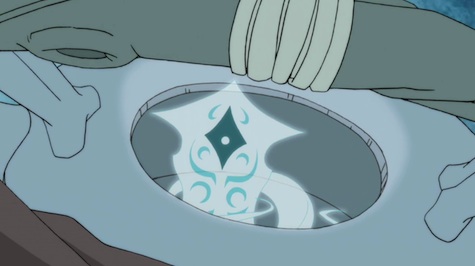
So here is a thing about me. You can’t just say “oh, there are probably a dozen lion-turtle cities” and then turn around and only show me four. Fire, air, water and earth but…what about the others? Some repeats of those four? Other bending arts, now lost? A “new world” on the other hemisphere of the globe? Spelljammer? Okay, I am probably reading into it, but a mythology episode begs cosmological questions, like: what about the stories of the first benders, of Oma and Shu, learning from badger-moles? Is the dragon we see tutoring Wan meant to be the root of the Sun Warrior’s legends? (Frankly, I just enjoyed the fanservice in having the dragon dance show up again.) How much cultural distortion has occurred over the past thousand years? After all, no legend can stay the same for that long.
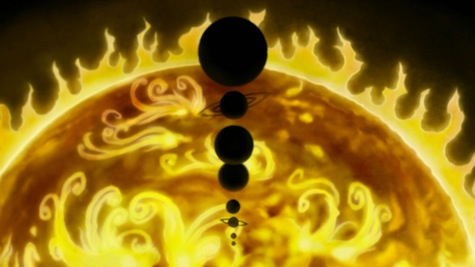
A few miscellaneous questions I’ve still got kicking around—or general observations, or what have you—continue to ferment in the back of my mind. Like, hey, did we just see what the solar system of the planet the Avatar cycle happens on? That kind of background worldbuilding really wets my whistle for more. The big strokes of Wan’s story, like dragon-turtle cities, are all obvious “heck yeah!” awesome moments, but the small moments of wonder, that is what I’m a sucker for. I remember hearing an anecdote about Tolkien when I was in elementary school, that he’d figured out the cycles of the moon in order to have the Fellowship see the proper moons at the proper time; that seemingly insignificant details that are in fact hints of an underlying machinery of consistency in storytelling are the underpinnings of verisimilitude, if you ask me.
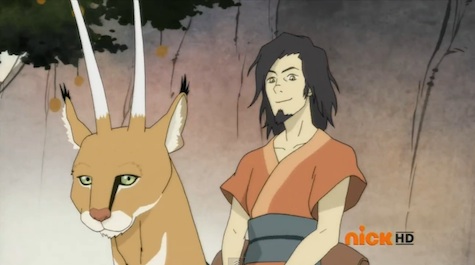
The biggest unanswered question, the obvious dangling thread, is: what is the deal with spirit possession? We see it physically deforming Yao and the man that the aye-aye spirit jumps inside of. One part of me just says that it is to show that there are dire consequences for when humans and spirits merge, to foreshadow the ramifications of Raava and Wan merging together—but another part of me just thinks it is very curious. First, we see all the chimeric creatures of the Avatar-verse, and I wonder if an even earlier mingling of spirits was behind that. Second, it makes me aware that a profoundly different world could spool out of this story. It is entirely possible that rather than just “reset” the world by saving the day, Korra will start a new world, that she might…I don’t know, merge with Vaatu, balancing the spirits in her, and allowing the portals to remain open, and incarnate spirits to become common again. (I mean, Wan’s statue at the Air Temple has both Raava and Vaatu’s markings, when it lights up, doesn’t it?)
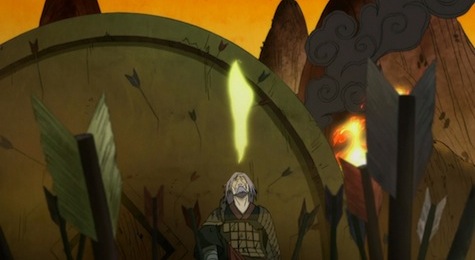
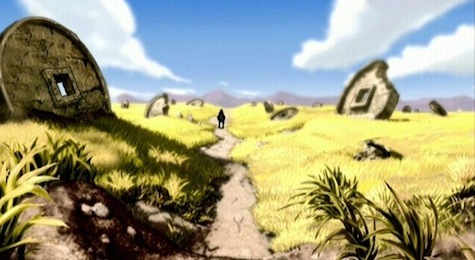
How about Wan’s final battle? He dies—complete with Doctor Who regeneration sparkles—amidst those giant stone coins, which as folks on Tumblr noticed, look to be pretty much the same place as where Zuko goes off to in his lone wanderings. See, little background elements, that is what ties a world together. The big things, like the not-too-subtle yin and yang art direction, are great, but I want to know…how do the black and white fish at the Northern Water Tribe link to Vaatu and Raava? Why is there a Little Prince-style baobab as the only notable feature in the Spirit World between the two gates? Or, when is the next convergence? Astrology has always been important to these stories; the sun, the moon, the comet—what other surprises do the stars hold? Was it just my imagination, or did it look like Vaatu was bound to the moon when Wan was imprisoning him?
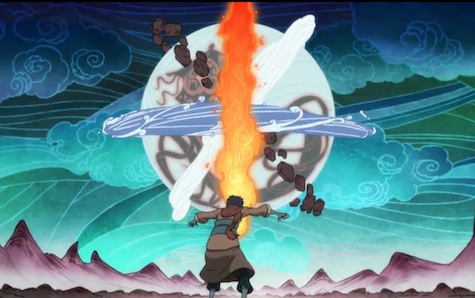
I was really excited that this episode didn’t fool around, didn’t waste time. Amnesiac Korra, here, meet a fire witch and then get dipped into a crystal cave’s lake, obviously. Here, talk to Aang real quick, Roku, Kiyoshi—Kiyoshi, you are the best—and then boom, Wan. No “go find the MacGuffin” or “but who am I?” wheel-spinning. Just an economy of storytelling. Wan starts right off with his Aladdin-esque street-rat shenanigans, and Steven Yeun does a great job. We meet Mula, giving the first Avatar a suitably weird animal companion in a cat-deer (complete with more shades of Miyazaki; or at least, it made me think of the elk from Princess Mononoke). We don’t have the answers we need to solve the riddle of the season—why would dark spirits be fighting the Avatar when she tries to open the portal, if Raava is behind everything? Raava should want to open the portals!—but we have a lot more to go on.
Mordicai Knode sort of wants the spirits to come back to the rest of the episodes can have the great abstracted art style of “Beginnings.” He also wonders: did Raava & Vaatu remind anyone else of the game Journey? Find Mordicai on Tumblr and Twitter.










